PretensT
Tensegrity is a special kind of structure made of push and pull.
Project maintained by elastic-interval Hosted on GitHub Pages — Theme by mattgraham
Breaking a rule
I think of the tensegrities that I build as following some very strict rules, and of those rules number one is probably bars may not touch each other.
That way tensegrities are always nothing more than a connected network of purely pushing and pulling things. There is no bending or shear stress worth considering (if it’s done well, I suppose).
I really don’t like to break this rule.
Symmetry’s sake
But then I look at my own body, and my arms and legs clearly have a spiral nature to them which I have come to associate with the twists of these tensegrity structures.
That makes me want to try and put the two together, but when I did that, I came into conflict with my main rule.
Imagine any tensegrity structure, even a very simple one, and then imagine holding it up to a mirror. When you bring it closer to the mirror you can see that the twist in the mirror has opposite chirality, left vs right twist.
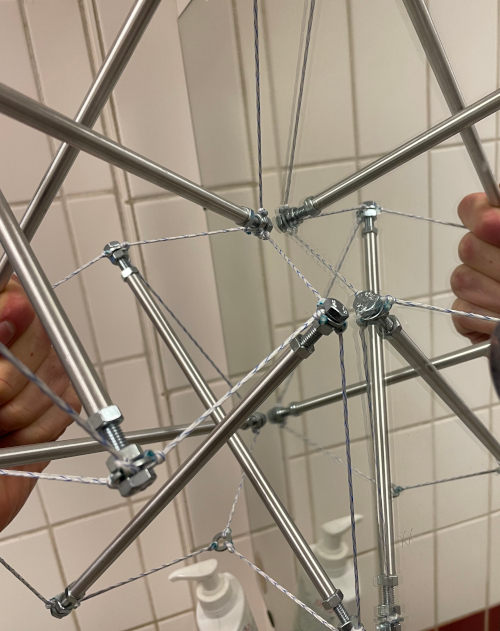
Of course your left hand looks like your right hand in the mirror as well.
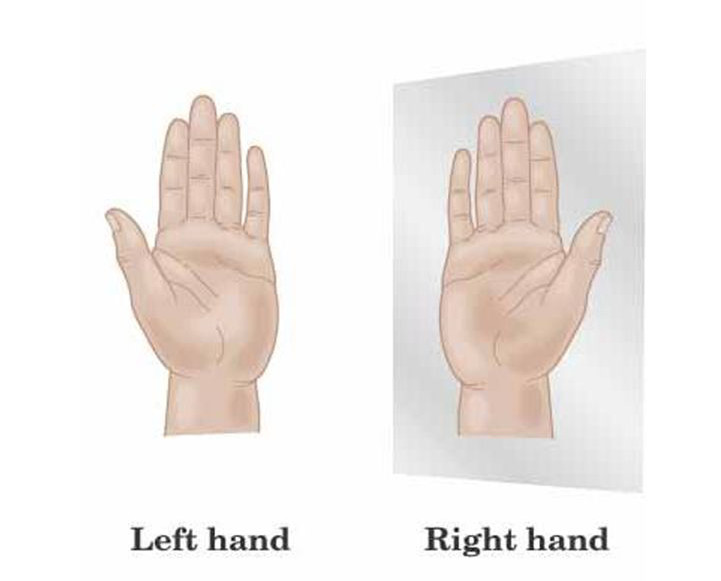
But that means that if you want to connect the two opposite tensegrities together (the real one and its mirror image), then bars are going to touch bars!
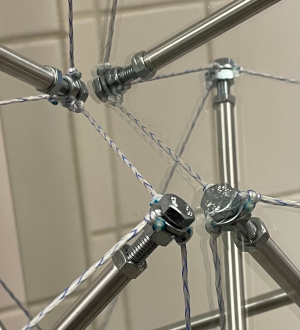
I guess that there is no option but to surrender.
Okay but
To make a kind of tensegrity body, I will need the bilateral symmetry of the mirror image, but the bars that touch don’t have to make one straight bar.
In fact they appear to be often quite V shaped, so we can try our best and make it a hinge connection or an elbow, able to freely narrow and widen the angle between the two.
Compromise accepted, for the sake of symmetry.
I decided to try and build something like a body.
Headless Hug
All the necessary machinery was already in place from my previous work with the app to explore this design space.
When I generate new branches of tensegrity with opposite chirality, the opposite twists look kind of like limbs.
By scaling down gradually while growing and doing a little shaping by pulling things together before freezing the design, I could generate something that looked pretty much like a human body.
Of course it lacked a head, but that was very much beside the point, given how well the rest worked, so I decided that headlessness could be seen as a feature rather than a bug.
The limbs were each a sequence of twists of the same chirality, but then later I even got fancy and switched to the other twist direction at more or less the “knee” and “elbow” locations. (You have to look very carefully to see this)
Prepared the parts
So it was time to build, and I started by preparing the right number of bars, each group cut to the correct size.
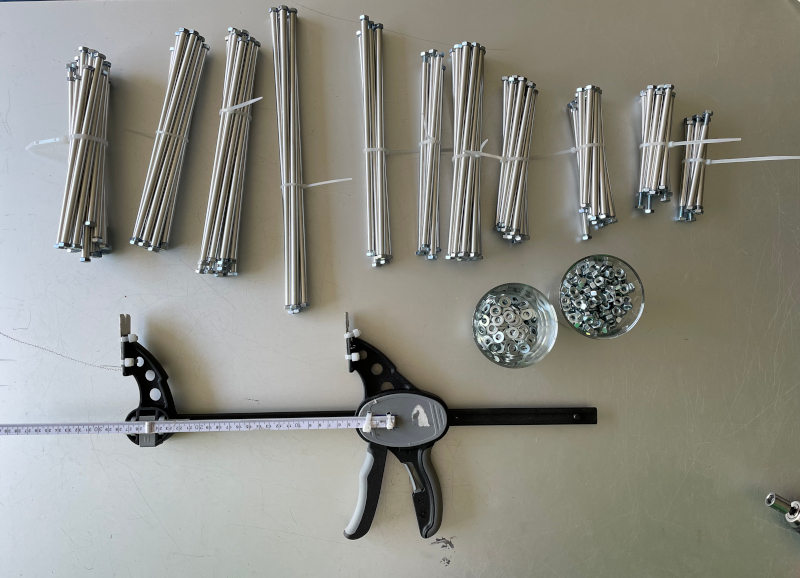
And now that I have my handy measuring tool for making any specific cord lengths to about the millimeter, I was ready to assemble.
Bottom up
I started at the bottom, building the two columns which would come together at the crotch to become the legs. It was useful to tape them down for now.
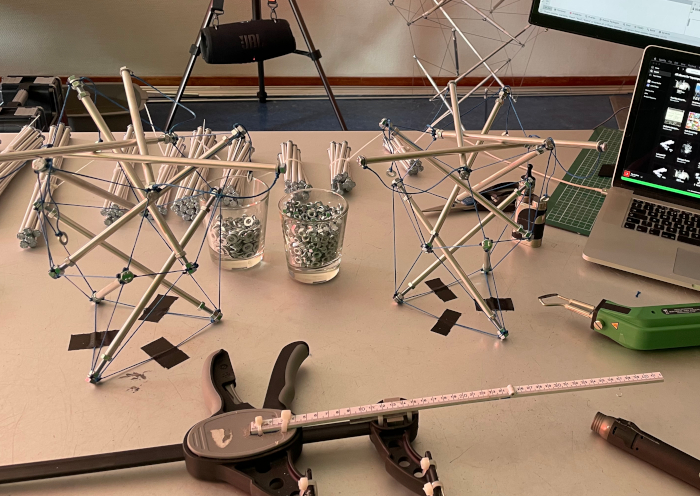
Every step of the way, I would have to read out the next cord length from the computer model.
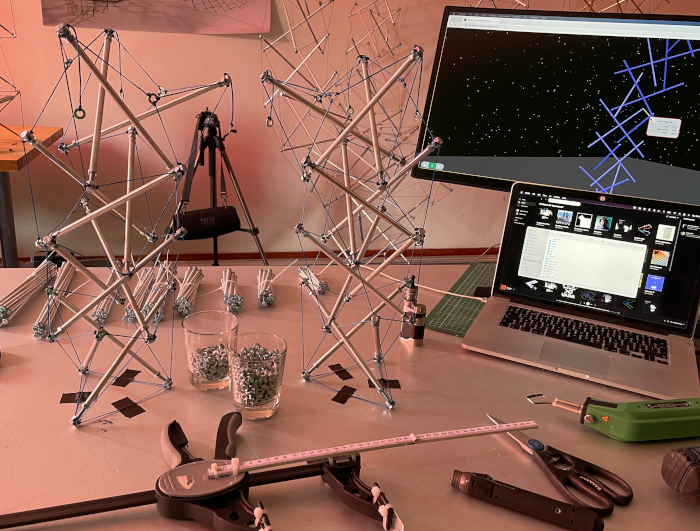
Hot knife, blowtorch, measure tool, drill for the bolts.
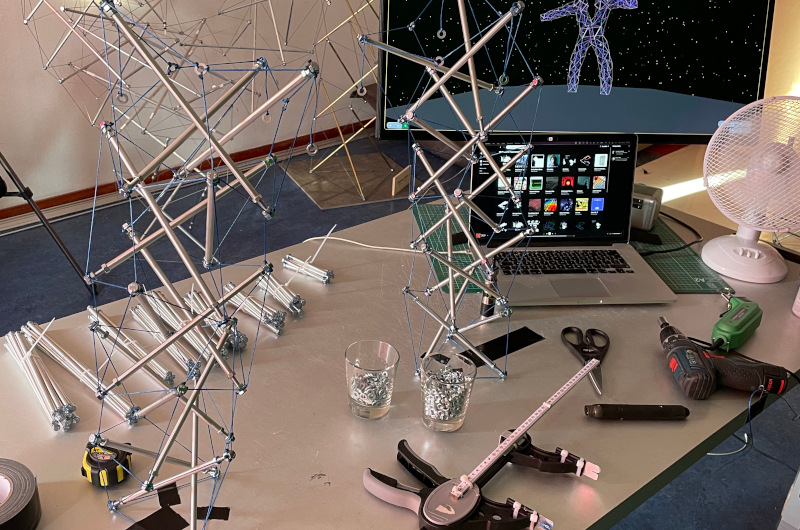
The crotch
Now we get into trouble. I ask you, when is the crotch not a source of trouble?!
At the crotch, we have to break the rule. I cobbled together a limited kind of “hinge”, which could work because it really wouldn’t have to hinge much.

The bar ends that inevitably come close together (like in the mirror) when opposite chirality columns come together can be held carefully at a distance with this little C shaped piece of metal.
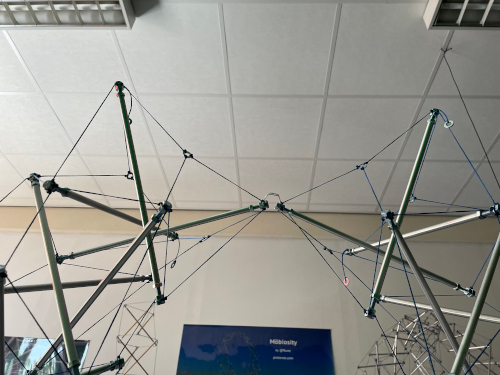
The legs have met at the crotch! Now to proceed with the abdomen and further.
Abdomen
The abdomen is one of those “omni-twist” that I talked about in the convergence projects.
Building this on top of what were two leg towers was fairly tricky.
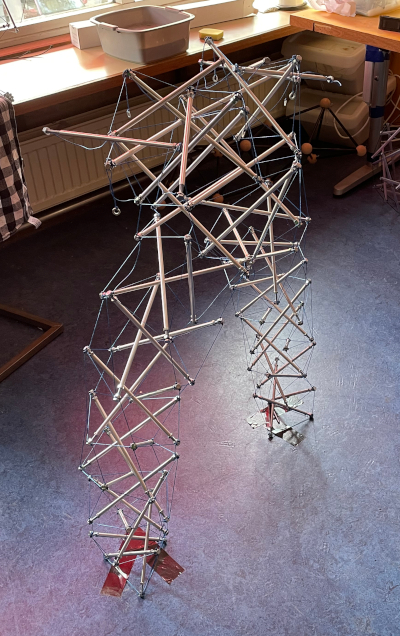
The problem of bar ends meeting is not only at the crotch but also at on the other side of the omni-twist, at, the bottom of the back.
And of course, there’s also no avoiding this situation in the armpits as well. Here I’ve marked all the rule violations with a green dot:
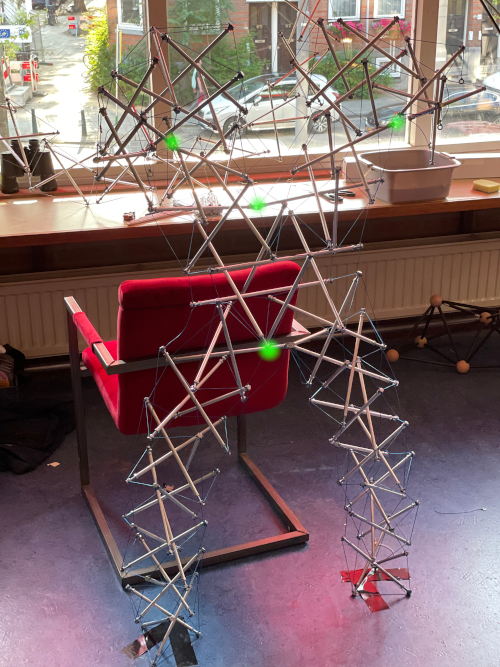
Now with the shoulders in place, all that was left was building down the arms.
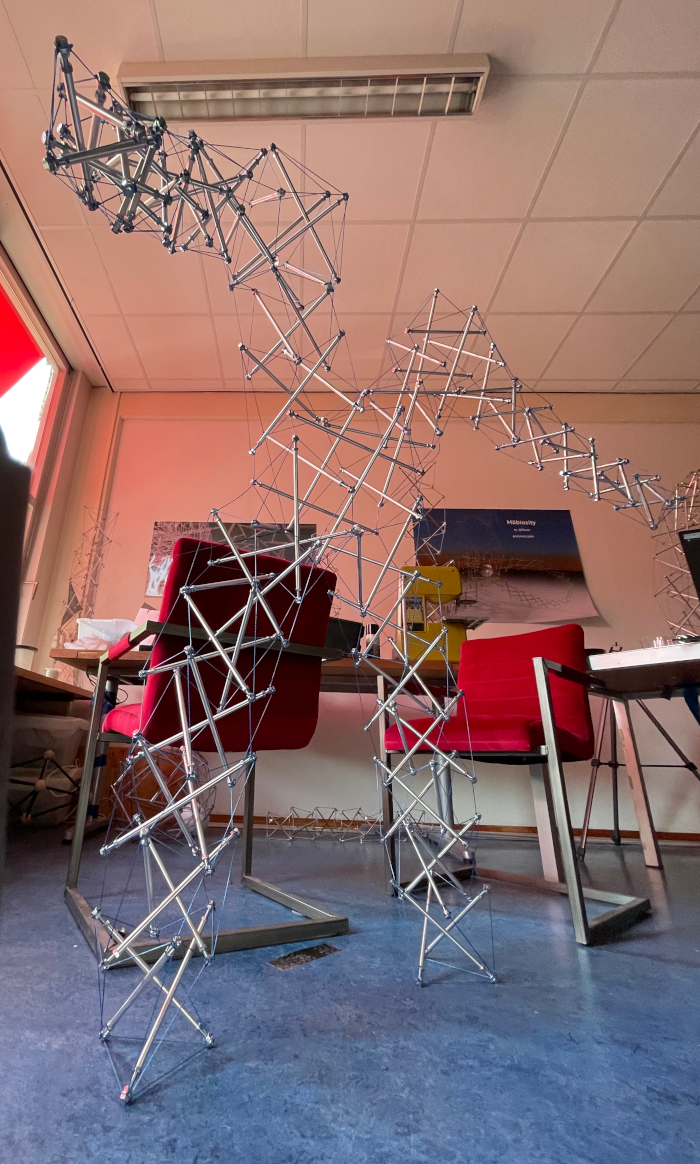
Done!
I took him out to the hallway for a picture.
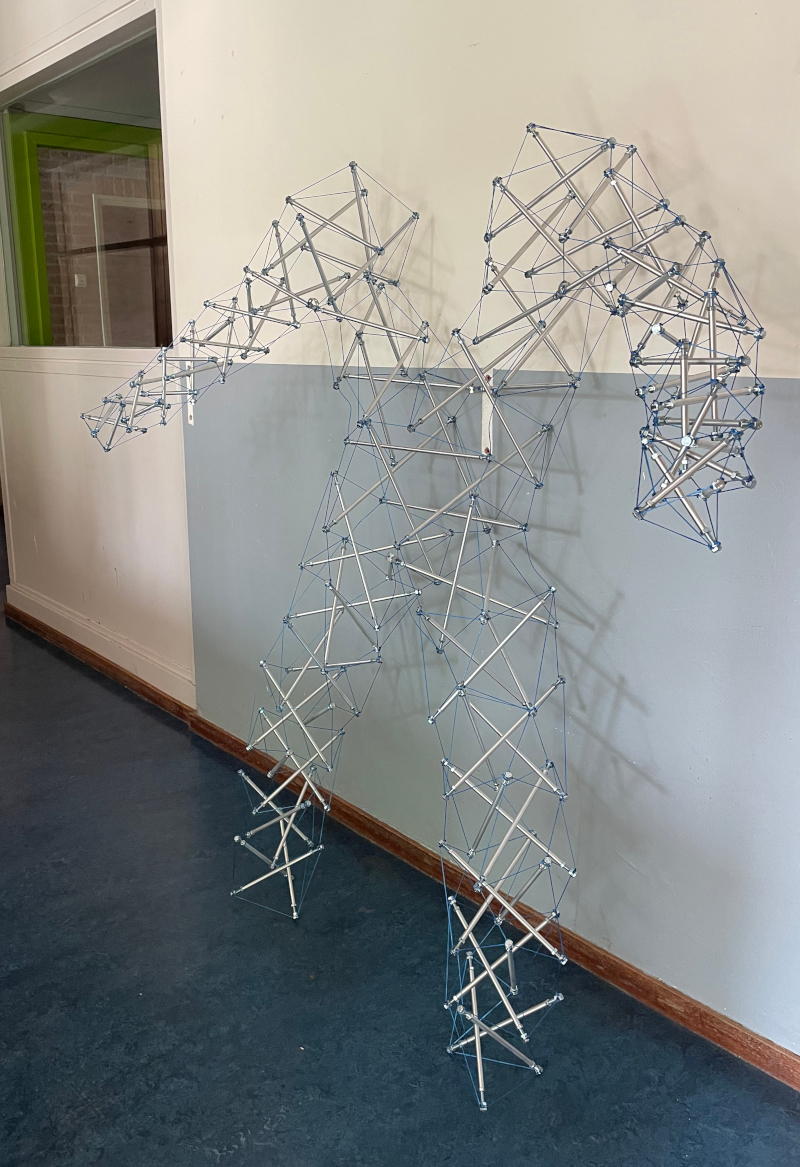
Let’s see what he looks like as a surfer!
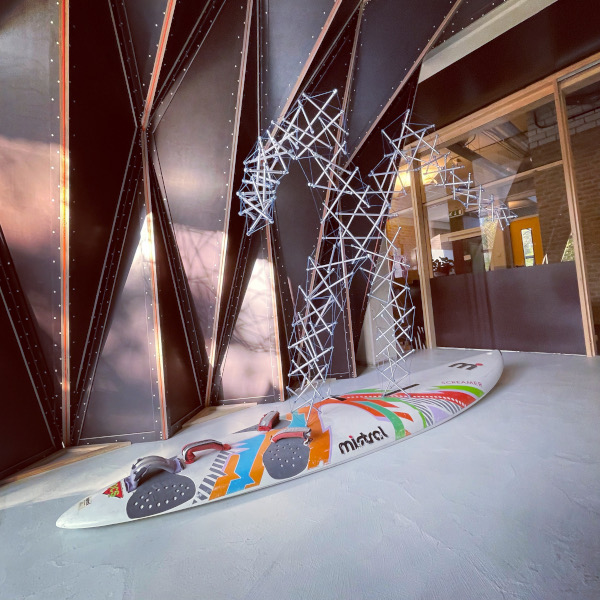
Conclusion
This project took literally from monday morning to friday night, a whole week of building. It was hard to break my main rule, but it was for a good cause.
I made the compromise by building hinge-like connections between bar ends which would otherwise have conflicted with each other, but as a result I was able to play with the opposing chirality or spiralness which we see in our bodies.
Projects:
2024-07-23: "Bouncy Wooden Sphere": what you can do with a discarded bed2024-04-23: "Twisted Torque": tied into a permanent twist
2023-03-27: "Easy 30-Push Sphere": one simple element
2022-10-05: "Glass and LED": going big and colorful
2022-09-29: "Fascia": dancing with tensegrity
2022-08-30: "Mitosis": the four-three-two tensegrity
2022-08-04: "Push Bolts for the People": finalizing design and getting it out there
2022-06-22: "Head to Head Push Bolt": M5 and M6 bolts symbiosis
2022-05-30: "Hiding Knots": bump up the aesthetics
2022-05-25: "Innovation with 3D Printer": the push bolt
2021-12-02: "Headless Hug": breaking a rule for the sake of symmetry
2021-10-28: "Rebuilding the Halo": finally got it right
2021-10-20: "Convergence": growing and reconnecting
2021-07-27: "120-Strut Brass Bubble": taking the next step up in complexity
2021-05-26: "30-Strut Brass Bubble": bouncing spherical tensegrity
2021-04-08: "Bow Tie Tensegrity": better bend resistance
2021-03-29: "Six Twist Essential": what if more hands could see?!
2021-01-25: "Minimal Tensegrity": no more tension lines than absolutely necessary
2021-01-18: "Degrees of Freedom": first adjustable hybrid tensegrity
2021-01-11: "Fractal Experiment": a tensegrity of tensegrities
2020-12-09: "Axial Tension": pretensing what is already pretenst
2020-11-02: "Halo by Crane - Part 2": the strengthening
2020-10-26: "Halo by Crane - Part 1": assembly complete but strength lacking
2020-10-12: "Brass and Tulips": a tight and strong tensegrity tower
2020-08-10: "Prefab Tension Tower": the tower of eight twists
2020-07-27: "Elastic Bubble": building with elastic ease
2020-07-13: "The Twist Sisters": left-handed and right-handed
2020-07-06: "Radial Tension": Pulling towards the middle
2020-06-22: "Diamond of Tension": Four pulls for every push
2020-06-15: "Prefab Tension": Separating compression from tension